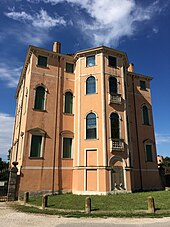Vo 'Vecchio concentration camp
The Vo 'Vecchio (Padova) concentration camp was one of over 30 Italian provincial concentration camps ( Italian campo di concentramento provinciale ) set up by the Italian Social Republic to intern Jews awaiting deportation . The camp was in operation from December 3, 1943 to July 17, 1944.
history
The 17th century Villa Contarini-Venier in the Vo 'Vecchio part of the municipality of Vo' originally served the congregation of the Sisters of St. Elisabeth as a summer residence. In December 1943 it was converted into an internment camp for Jews from the provinces of Padua and Rovigo on the basis of the Police Ordinance No. 5 issued on November 30, 1943 by the Minister of the Interior of the RSI Guido Buffarini-Guidi . The four floors of the villa offered enough space for a maximum of 60–70 internees. The management of the camp was entrusted to Italian police officers. The nuns took care of the food.
The camp was disbanded on July 17, 1944. On that day, a German unit first brought the 47 Jews present in the camp to Padua . The men were housed in the prison in Piazza Castello, the women in the prison of the Paolotti church, which was demolished in 1966, in Via Belzoni. On July 19, the prisoners were sent to the Risiera di San Sabba concentration camp , and from there on July 31 to Auschwitz , where they arrived on August 3. Only three women survived the extermination: Bruna Namais, Ester Hammer Sabbadini and their daughter Sylvia Sabbadini.
A detailed written record of the events in the camp, from its establishment to its liquidation, was made by the pastor Don Giuseppe Raisa and is kept in the parish archives of Vo 'Vecchio.
present
In the early 1950s, the villa became the property of the municipality of Vo '. On July 17, 2001, a plaque commemorating the deportees was placed on the street side of the building. In 2006, the city council began a renovation project to enable the building to be used for “public use of cultural nature”, taking into account: “Villa Contarini Venier is also and will be a place of remembrance of the Holocaust , regardless of its use to remain for future generations. For this reason, certain paths are marked with commemorative signs to remember the Jewish citizens who sadly passed by on the way to their extermination. "
List of deported Jews (including the three survivors)
- Ada Ancona
- Irma Ancona
- Emma Ascoli
- Gemma Bassani
- Elisa Belaar
- Clara Bindefeld
- Sigismondo Bindefeld
- Oscar Coen
- Eugenio Coen Sacerdoti
- Amalia Dina
- Giovanna d'Italia
- Bruno Franco
- Enzo Franco
- Frid Frieder
- Elia Gesses
- Sara Gesses
- Ester Hammer
- Lazzaro hammer
- Samuele Heller
- Anselmo Jacchia
- Ercole Jacchia
- Ida Jacchia
- Pasqua Jacchia
- Eva Kapper
- Gustavo Kapper
- Pietro Kapper
- Ada Levi
- Alvise Levi
- Augusto Levi
- Marco Levi
- Mario Levi
- Augusto Levi Minzi
- Geltrude Lorent
- Ida Moresco
- Bruna Namibia
- Emma Orefice
- Italo Parenzo
- Ada Pesaro
- Elsa Rothschild
- Caterina Rudol
- Elio Sabbadini
- Sylva Sabbadini
- Gisella Sullam
- Teresa Supino
- Evelina Valabrega
- Umberto Valabrega
- Anna Zevi
Related articles
Web links
- Franca Cecchinato: Da Vo 'ad Auschwitz. In: Uni Padua online newspaper. September 1, 2012 (Italian).
- Villa Contarini Giovanelli Venier by Vò Vecchio. In: visitabanomontegrotto.com. October 7, 2015.
Individual evidence
- ↑ L. Picciotto, I campi di concentramento provinciali per ebrei, 1943–1945. In: cdec.it . Retrieved January 17, 2019 (Italian).
- ^ Carrarese Castle. In: padovamedievale.it. Retrieved January 17, 2019 .
- ↑ Quoted and translated from: Comune di Vo '(Ed.): Il complesso di Villa Contarini Giovanelli-Venier a Vò. Studi preliminari al progetto di restauro e di recupero funzionale. Edited by Antonio Draghi.
Coordinates: 45 ° 19 ′ 42.2 ″ N , 11 ° 37 ′ 9.3 ″ E


